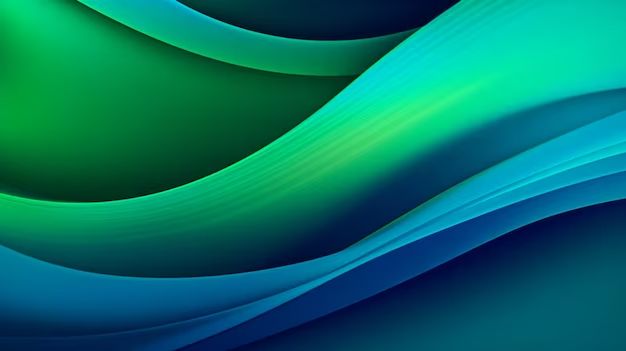Deep blue-green is a rich, saturated shade of blue-green that evokes a sense of depth and intensity. It sits between standard blue and green on the color wheel, combining the cool tranquility of blue with the vitality and growth of green. This striking blend encapsulates the beauty of the sea and nature in a single vibrant hue.
The Meaning and Symbolism of Deep Blue-Green
So what does this mystifying color actually represent? Here are some of the most common symbolic meanings and associations of deep blue-green:
- Calmness and relaxation – Like blue, deep blue-green evokes a soothing, peaceful feeling. Its darker and richer nature adds a sense of the depths of the ocean or tranquility of nature.
- Life and renewal – The green aspect brings to mind new growth, health, and the lifeforce of plants. It suggests renewal and vigor.
- Creativity and inspiration – Connected to the stimulating effect of green, deep blue-green can represent creativity and inspiration. It energizes the spirit.
- Exploration and adventure – The depths of this oceanic color speak to the promise of exploration. It suggests exciting adventures into the great unknown.
- Sophistication – Deep blue-green has an elegant, refined quality. Deeper than standard green, it has an air of sophistication and intrigue.
So in summary, this multifaceted hue combines the rejuvenating properties of green with the sophisticated serenity of blue. It stirs up sensations of renewal, creativity, and exploration.
Deep Blue-Green in Nature
One of the most striking aspects of deep blue-green is its prevalence in the natural world. Here are some of the places you can spot this intense, verdant shade:
- Oceans – The dark depths of the sea reveal stunning blue-green hues, from turquoise tropical seas to deeper teal tones.
- Landscapes – Lush rainforests, mossy gardens, and rolling hills often produce shades of rich blue-green.
- Gems and minerals – Vibrant stones like emerald, jade, turquoise, and malachite exhibit the beauty of nature’s blue-green palette.
- Plants and flowers – Varieties like hydrangea, eucalyptus, succulents, and Hosta leaves display deep blue-green tones.
- Butterflies and insects – Iridescent wings and bodies often shimmer in shades ranging from teal to green-blue.
- Birds and fish – Peacocks, macaws, parrots, betta fish, and more sport feathers and scales in blue-green hues.
As these examples reflect, deep blue-green color permeates the natural landscape, from the sea to the sky. It provides balance and brilliance across various ecosystems and organisms.
The Science and Psychology of Deep Blue-Green
Let’s explore some of the scientific factors that produce and influence deep blue-green:
Pigment Mixing
In basic color theory, combining the pigments of blue and green produces blue-green shades like teal and turquoise. The more green pigment added, the closer the color shifts towards green. The more blue, the deeper and cooler the hue.
Light Wavelengths
Blue-green sits between the wavelengths of blue (450-495 nm) and green (495-570 nm) on the visible color spectrum. Mixing these wavelengths creates the various shades of blue-green.
Perception and Psychology
Research suggests that the color blue-green has the following psychological effects:
- Promotes relaxation and reduces stress and anxiety
- Evokes feelings of balance, harmony, and equilibrium
- Stimulates creativity, exploration, and renewal
- Provides a sense of sophistication, growth, and vitality
- Improves focus and enhances productivity
So in addition to its aesthetic appeal, blue-green also delivers real psychological benefits. The combination of calmness from blue and uplifting energy from green makes it ideal for spaces where relaxation or creativity are desired.
Uses and Applications of Deep Blue-Green
This multifaceted color has emerged in a variety of contexts. Here are some of the most prominent applications and uses of deep blue-green:
Interior Design
From accent walls to furniture, deep blue-green makes a bold yet calming interior design statement. It works in styles like beachy, bohemian, modern, and eclectic rooms.
Fashion
Deep teal, emerald, and turquoise shades complement a wide range of skin tones. They stand out in clothing, shoes, jewelry, and accessories.
Branding
Many brands leverage blue-green’s blend of professionalism and vibrancy. It’s popular in sectors like finance, technology, hospitality, and more.
Nature Photography
From coral reefs to rainforests, deep blue-green landscapes make stunning subjects. The color pops against darker blues and greens.
Spa and Wellness
Blue-green palettes cultivate relaxation in spas, yoga studios, and therapeutic settings. The hue promotes de-stressing and rejuvenation.
Sports Teams
The Seattle Seahawks, Memphis Grizzlies, and Miami Dolphins represent just a few sports franchises that have adopted blue-green as their official team color.
As you can see, deep blue-green serves many purposes across a broad spectrum of industries and interests.
Deep Blue-Green Palette Shades
Like any color, blue-green encompasses a wide palette of shades and tints. Here are some of the most popular:
| Shade Name | Hex Code |
|---|---|
| Deep Teal | #006666 |
| Dark Turquoise | #00ced1 |
| Emerald Green | #50c878 |
| Peacock Blue | #33a1c9 |
| Seafoam Green | #90e4c1 |
| Jade Green | #00a86b |
| Viridian | #40826d |
| Cyan | #00ffff |
| Petrol | #005f6a |
| Aquamarine | #7fffd4 |
The possibilities are endless for deep blue-green. Darker, cooler hues like deep teal and emerald complement lighter tints like seafoam. All produce the signature tranquil yet refreshing effect.
Conclusion
With its blend of blue’s calm stability and green’s refreshing vibrance, deep blue-green represents equilibrium and multifaceted potential. It promotes relaxation as well as creative energy. This symbolic, nature-filled hue can stimulate, soothe, inspire, and more. Deep blue-green’s nuanced ability to evoke adventure, sophistication, renewal, and serenity in a single vibrant color makes it universally captivating.


